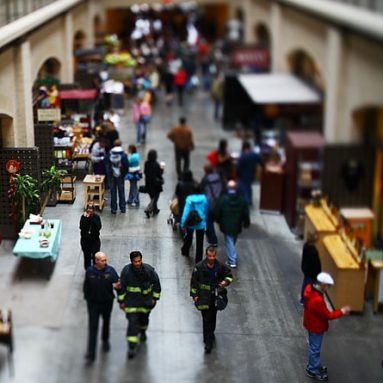Indoor ozone stopper
Oils from human skin fight off this harmful chemical, but at a cost.
Ozone is a chemical that can be both friend and foe to human beings — depending on where it is. In the atmosphere, high overhead, ozone protects Earth from harmful radiation that comes from the sun. But at Earth’s surface, ozone is better known as air pollution, and breathing it can be dangerous.
Going inside is safer, but it doesn’t completely protect a person from pollution: Ozone can creep into buildings and homes and still pose a threat because it irritates the lungs. Inside a building, levels are much lower than outside because ozone changes when it runs into something like furniture. A new study identified yet another layer of protection that keeps ozone out of our bodies — human skin.
 |
|
Our bodies continuously shed flakes of skin hosting ozone-busting oils that accumulate in house dust and on surfaces.
|
| Kudumomo/Flickr |
Skin contains many different kinds of oils. It’s easy to see: Just press your finger against a sheet of glass and observe. Your fingerprint is outlined in oil. When ozone in the air meets the oils in human skin, there is a chemical reaction. That means that the molecules of ozone — and possibly the molecules of oil — change.
Ozone is a lot like the oxygen we breathe. The kind that we breathe is made of diatomic molecules, which means each molecule has two atoms. But ozone has an extra: It is made of three oxygen atoms connected together. This extra atom makes ozone behave differently than typical oxygen. Ozone is both poisonous and protective.
For the new study, the scientists gathered information about the dust in the bedrooms of 500 children who live on the Danish island of Fyn. This dust, the scientists found, contained many different chemicals. One was a phthalate, which is a controversial chemical found in many plastics and other materials and that might harm to the hormone balance in humans. The scientists weren’t surprised to find a phthalate because these chemicals are everywhere.
They were surprised to find large amounts of cholesterol and squalene. (Squalene is a fat that makes up about 10 percent of the oil in human skin.) Then the researchers realized that both of these things can be found in human skin. The human body regrows its outer layer of skin every two to four weeks, and bits and pieces of the old skin break off — to become dust.
In this study, the researchers determined that skin flakes on surfaces were covering those surfaces with squalene, thus making those windows, doors or couches break up ozone as well as skin does.
“We’ve known that the ozone indoors is being gobbled up,” Charles Weschler told Science News. “But we really didn’t know what’s doing the gobbling.” Now, he finds, “this squalene is just great at chewing up ozone.” Weschler, a scientist at the University of Medicine and Dentistry, New Jersey, in Piscataway, worked on the new study.
It may seem like good news that human skin helps indoor spaces fight off dangerous ozone. After all, if the ozone goes away, then a person won’t breathe it and face the bad health effects.
But that may not be the case: Emerging research suggests this battle with ozone might present its own dangers.
 |
|
Regions that host crowds stand to accumulate the most squalene, and any toxic pollutants that form during its reactions with ozone.
|
| Kuchingboy/Flickr |
In a different experiment, scientists in Austria mixed together ozone and skin oils in the laboratory. They found that, even though this mixing gets rid of ozone, it also creates new kinds of pollution. One in particular, called 4-oxopentanal (or 4-OPA), might be particularly dangerous. Until now, scientists have not analyzed 4-OPA to see how toxic it is, but that’s changing.
Yet another team of scientists are working on this chemical at the National Institute for Occupational Safety and Health in Morgantown, W.V. In early studies, the researchers found evidence that 4-OPA may be even worse than ozone. In other words, the ozone may be gone — but what’s left in its place may be even worse for human health.
In the end, scientists want to know exactly what’s going on with the molecules that we breathe — and they hope this information will help us find new ways to protect our health. But the scientific journey from the first experiment (in the children’s bedrooms) is long, requiring study after study by scientists who can learn from each other.
Going Deeper:
* Raloff, Janet. 2010. “The skinny on indoor ozone,” Science News, March 25. http://www.sciencenews.org/view/generic/id/57596/title/Science_%2B_the_Public__The_skinny_on_indoor_ozone
Sohn, Emily. 2006. “Sun screen,” Science News for Kids, July 12. http://sciencenewsforkids.org/articles/20060712/Feature1.asp







